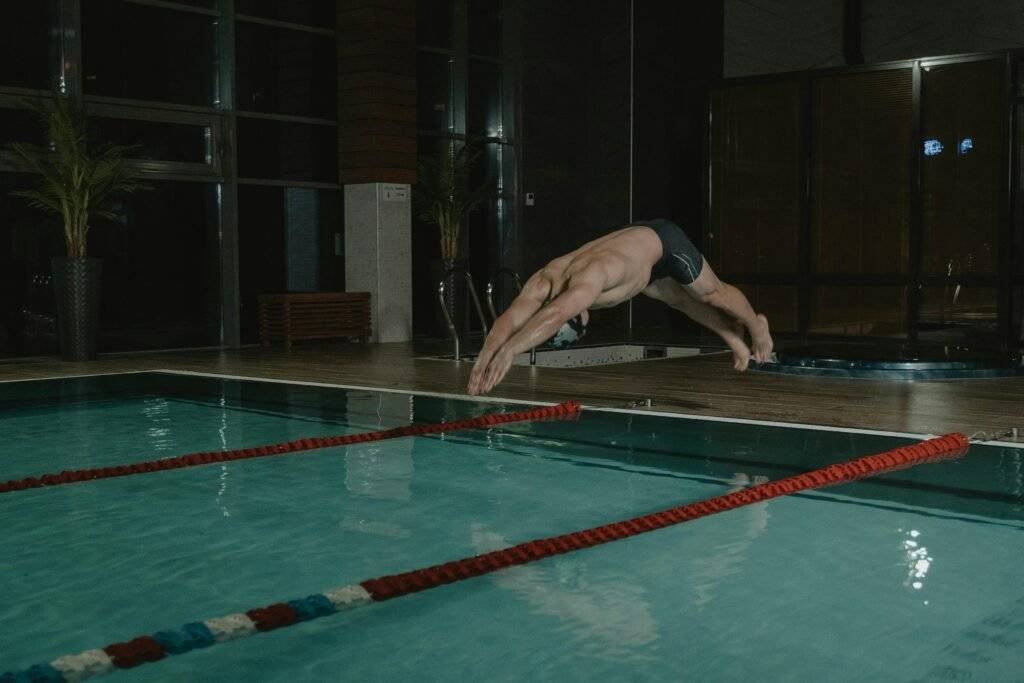Water Aerobic Exercises for All Age’s
Water aerobic exercises, often talk about to as water aerobics, involve performing aerobic activities in a pool. These exercises pull the resistance of water to provide a complete workout that is gentle on the joints while effectively building strength and improving heart health.
As a low-impact exercise, water aerobics is particularly beneficial for individuals with arthritis, those recovering from injuries, and older adults seeking a safe and effective way to stay active.
However, its benefits extend to people of all ages and fitness levels, making it a universally advantageous form of exercise.

Types and Categories of Water Aerobic Exercises
- Shallow Water Aerobics
Shallow water aerobics is performed in water that is typically waist to chest-deep. These exercises include activities such as water walking, jumping jacks, and leg lifts, which are designed to improve heart health and muscle strength while minimizing stress on the joints.
- Deep Water Aerobics
In deep water aerobics, participants perform exercises in water where they cannot touch the bottom. This type requires the use of flotation devices such as buoyancy belts to keep the body afloat.
Deep Water aerobics provides a full body workout and is excellent for improving core strength and power.
-
Water Walking
Water walking is a simple yet effective exercise where participants walk in the pool. The water’s resistance improves the workout, making it more challenging than walking on land. It is ideal for improving cardiovascular health and leg strength.

-
Aqua Zumba
Aqua Zumba combines the energetic dance moves of Zumba with the resistance of water. This fun and lively workout helps improve coordination, balance, and heart health while burning calories. cardiova
-
Water Yoga
Water yoga adapts traditional yoga poses for the aquatic environment. The buoyancy of water supports the body, making it easier to achieve and hold poses. Water yoga enhances flexibility, balance, and relaxation.

-
Water Pilates
Water Pilates focuses on core strength, flexibility, and posture. The exercises are performed in a pool, using the water’s resistance to challenge and tone the muscles.
- Aqua Jogging
Aqua jogging involves jogging in the water with the help of a buoyancy belt. This exercise is excellent for heart conditioning and muscle strengthening without the impact on joints related with land jogging.
-
Hydrotherapy Exercises
Hydrotherapy exercises are therapeutic exercises performed in water, often used in rehabilitation programs. They help improve mobility, reduce pain, and promote recovery from injuries or surgeries.
Benefits of Water Aerobic Exercises
Low-Impact on Joints
One of the most significant advantages of water aerobics is its low-impact nature. The buoyancy of water reduces the stress on joints and bones, making it an ideal exercise for individuals with arthritis, joint pain, or those recovering from injuries.
Improved Heart Health
Water aerobics is an excellent way to improve heart health. The resistance of water increases the intensity of the workout, helping to strengthen the heart and improve circulation.
Enhanced Muscle Strength and Tone
The resistance provided by water helps build muscle strength and tone. Water aerobics engages multiple muscle groups simultaneously, leading to balanced muscle development.
Increased Flexibility
Performing exercises in water can improve flexibility.The water supports the body, allowing for a greater range of motion and reducing the risk of injury.
Weight Management
Water aerobics can aid in weight management. The combination of heart and strength training helps burn calories and build lean muscle mass, contributing to weight loss and overall fitness.
Reduced Stress and Anxiety
Exercising in water has a calming effect on the mind and body. The soothing properties of water can reduce stress and anxiety, promoting mental well-being.
Rehabilitation and Physical Therapy
Water aerobics is widely used in rehabilitation and physical therapy. The gentle resistance of water helps improve mobility, strength, and balance in individuals recovering from surgeries, injuries, or chronic conditions.
Suitable for All Ages and Fitness Levels
Water aerobics is versatile and can be adapted to suit people of all ages and fitness levels. Whether you are a beginner or an advanced exerciser, water aerobics offers a challenging and effective workout.
Common Misconceptions About Water Aerobics
Not Just for the Elderly
A common misconception is that water aerobics is only for the elderly. In reality, water aerobics is beneficial for individuals of all ages, from children to seniors, due to its low-impact and high-resistance nature.
More Than Just Splashing Around
Another misconception is that water aerobics is not a “real” workout. On the contrary, the resistance provided by water can make exercises more challenging than their land counterparts, leading to significant fitness gains.
Effective for Weight Loss
Some people believe that water aerobics is not effective for weight loss.However, the combination of aerobic and strength training exercises in water aerobics can help burn calories and build muscle, contributing to weight loss and overall fitness.
Equipment and Gear for Water Aerobics
Water Shoes :Water shoes provide grip and support during water aerobics exercises, reducing the risk of slipping and protecting the feet.
Aqua Weights :Aqua weights are designed for use in water and help add resistance to exercises, enhancing muscle strength and endurance.
Noodles and Kickboards :Noodles and kickboards are versatile tools used for a variety of water aerobics exercises, providing support and resistance.
Water Gloves :Water gloves increase the surface area of the hands, adding resistance to arm movements and helping to tone the upper body.
Buoyancy Belts: Buoyancy belts help keep the body afloat during deep water aerobics, allowing for a full-body workout without the impact on joints.
How to Get Started with Water Aerobics
Choosing the Right Class
When starting water aerobics, it is essential to choose a class that suits your fitness level and goals. Look for classes that are specifically designed for beginners, intermediates, or advanced participants.
Finding a Certified Instructor
A certified water aerobics instructor can ensure that you are performing exercises correctly and safely. Look for instructors with certifications from reputable organizations such as the Aquatic Exercise Association (AEA).
What to Expect in a Class
In a typical water aerobics class, participants perform a variety of exercises designed to improve heart health, strength, and flexibility. Classes often include a warm-up, aerobic exercises, strength training, and a cool-down.
Tips for Beginners
Start slowly and gradually increase the intensity of your workouts.
Focus on maintaining proper form and technique.
Stay hydrated, even though you are exercising in water.
Listen to your body and rest if you feel fatigued.
Sample Water Aerobic Workouts
Beginner Routine
Warm-Up: 5 minutes of water walking
Cardio: 10 minutes of water jogging
Strength: 10 minutes of arm exercises with water
gloves
Flexibility: 5 minutes of stretching in the water
Cool-Down: 5 minutes of gentle water walking
Intermediate Routine
Warm-Up: 5 minutes of water walking with leg lifts
Cardio: 15 minutes of aqua Zumba
Strength: 15 minutes of leg exercises with aqua
weights
Flexibility: 10 minutes of water yoga poses
Cool-Down: 5 minutes of floating and relaxation
Advanced Routine
Warm-Up: 5 minutes of dynamic water stretching
Cardio: 20 minutes of deep water aerobics with buoyancy belt
Strength: 20 minutes of full-body exercises with noodles and kickboards
Flexibility: 10 minutes of advanced water yoga poses
Cool-Down: 5 minutes of gentle floating and deep breathing
Expert Insights and Trainer Tips
“Water aerobics is an excellent way to improve heart health and muscle strength while minimizing the risk of injury.”
Tips for Maximizing Benefits
- Combine water aerobics with other forms of exercise for a well-rounded fitness routine.
- Stay consistent and aim to participate in water aerobics classes at least 2-3 times per week.
- Focus on maintaining proper form to avoid injuries and maximize the effectiveness of the exercises.
Common Mistakes to Avoid
- Skipping the warm-up or cool-down
- Using improper form or technique
- Not staying hydrated
Quick review
In summary, water aerobic exercises offer a multitude of benefits, making them the ultimate workout for individuals of all ages and fitness levels.
From improving heart health and muscle strength to reducing stress and aiding in rehabilitation, water aerobics provides a complete and enjoyable workout.
Whether you are a beginner or an experienced exerciser, incorporating water aerobics into your fitness routine can help you achieve your health and wellness goals.
Give it a try and experience the Transformative effects of water aerobics for yourself.
